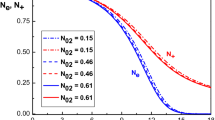Abstract
Accumulation of cold ions trapped within a space-charge-limited sheath collapses the sheath, causing a transition to the inverse sheath mode. A driving mechanism creating trapped ions is charge-exchange collisions which occur between fast ions and cold neutrals. Due to the complex nature of the temporally evolving sheath, it is difficult to predict how long the transition takes. Depending on the properties of the plasma, emitted electrons, and neutrals, the time scale can range from microseconds to hours. For experimental situations, it is important to understand whether the sheath will transition to an inverse mode within the observation time allotted. In this paper, we establish a theoretical basis for defining transition time of the sheath in terms of plasma properties. Calculations include an analytical approximation for the length of the virtual cathode, the amount of charged particles in each layer of the space-charge-limited sheath, and a time for its transition to the inverse sheath. The theoretical model is then compared to 1D kinetic simulations of a space-charge-limited sheath with charge-exchange collisions present. The results are applied to estimate transition time scales for applications in laboratory plasma experiments, the lunar sheath, and tokamaks.











Similar content being viewed by others
Notes
The actual distribution is correctly evaluated as a half Fermi–Dirac distribution [30]; however, this will not affect the structure of our solution.
REFERENCES
L. Tonks and I. Langmuir, Phys. Rev. 34, 876 (1929).
G. D. Hobbs and J. A. Wesson, Plasma Phys. 9, 85 (1967).
F. Taccogna, Europhys. J. 68, 7 (2014).
R. T. Farouki, S. Hamaguchi, and M. Dalvie, Phys. Rev. A 44, 2664 (1991).
J. P. Sheehan, Ph.D. Dissertation (University of Wisconsin, Madison, 2012).
J. P. Sheehan, N. Hershkowitz, I. D. Kaganovich, H. Wang, Y. Raitses, E. V. Barnat, B. R. Weatherford, and D. Sydorenko, Phys. Rev. Lett. 111, 075002 (2013).
D. Sydorenko, I. Kaganovich, Y. Raitses, and A. Smolyakov, Phys. Rev. 103, 145004 (2009).
A. I. Morozov and V. V. Savel’ev, Plasma Phys. Rep. 30, 299 (2004).
A. I. Morozov and V. V. Savel’ev, Plasma Phys. Rep. 33, 20 (2007).
M. D. Campanell and M. V. Umansky, Phys. Plasmas 24, 057101 (2017).
X. Wang, J. Pilewskie, H.-W. Hsu, and M. Horányi, Geophys. Res. Lett. 43, 525 (2016).
M. D. Campanell, Phys. Rev. E 97, 043207 (2018).
P. C. Stangeby, The Plasma Boundary of Magnetic Fusion Devices (IOP, Bristol, 2000).
M. D. Campanell, Phys. Rev. E 88, 033103 (2013).
A. D. Polyanin and V. F. Zaitsev, Handbook of Exact Solutions for Ordinary Differential Equations (CRC Press, Boca Raton, FL, 2003).
P. L. Bhatnagar, E. P. Gross, and M. Krook, Phys. Rev. 94, 511 (1954).
F. Greiner, T. Klinger, and A. Piel, Phys. Plasmas 2, 1810 (1995).
T. Klinger, F. Greiner, A. Rohde, and A. Piel, Phys. Plasmas 2, 1822 (1995).
M. D. Campanell and M. V. Umansky, Plasma Sources Sci. Technol. 26, 124002 (2017).
C. Yip, N. Hershkowitz, G. Severn, and S. D. Baalrud, Phys. Plasmas 23, 050703 (2016).
A. J. Dessler, Rev. Geophys. 5 (1), 1 (1967).
W. M. Farrell, A. R. Poppe, M. I. Zimmerman, J. S. Halekas, G. T. Delory, and R. M. Killen, J. Geophys. Res. 118, 1114 (2013).
J. H. Hoffman, Report NASA-CR-150946 (Texas Univ. at Dallas, Richardson, TX, 1975).
M. Benna, P. R. Mahaffy, J. S. Halekas, R. C. Elphic, and G. T. Delory, Geophys. Res. Lett. 42, 3723 (2015).
R. R. Hodges, Jr., J. Geophys. Res. 78, 8055 (1973).
S. A. Stern, Rev. Geophys. 37, 453 (1999).
R. Schwenn, Encyclopedia of Astronomy and Astrophysics (IOP, Bristol, 2000).
W. L. Fite, R. T. Brackmann, and W. R. Snow, Phys. Rev. 112, 1161 (1958).
J. A. Newbury, Eos 77, 471 (1996).
M. S. Sodha and S. K. Mishra, Phys. Plasmas 21, 093704 (2014).
J. A. Wesson, The Science of JET (JET Joint Undertaking, Abingdon, 1999), p. 56.
G. Z. Hao, W. W. Heidbrink, D. Liu, M. Podesta, L. Stagner, R. E. Bell, A. Bortolon, and F Scotti, Plasma Phys. Controlled Fusion 60, 025026 (2018).
N. G. Bolte, W. W. Heidbrink, D. Pace, M. V. Zeeland, and X. Che, Nucl. Fusion 56, 112023 (2016).
W. W. Dolan and W. P. Dyke, Phys. Rev. 95, 327 (1954).
M. E. Woods, B. J. Hopkins, G. F. Matthews, G. M. McCracken, P. M. Sewell, and H. Fahrang, J. Phys. D 20, 1136 (1987).
W. B. Nottingham, Phys. Rev. 49, 78 (1936).
E. W. Thomas and W. M. Stacey, Phys. Plasmas 4, 678 (1997).
O. Biblarz, R. C. Dolson, and A. M. Shorb, J. Appl. Phys. 46, 3342 (1975).
H. B. Garrett, Rev. Geophys. 19, 577 (1981).
B. F. Kraus and Y. Raitses, Phys. Plasmas 25, 030701 (2018).
ACKNOWLEDGMENTS
This work was performed under the auspices of the U.S. Department of Energy by Lawrence Livermore National Laboratory under Contract no. DE-AC52-07NA27344.
Author information
Authors and Affiliations
Corresponding author
Additional information
The article is published in the original.
Rights and permissions
About this article
Cite this article
Johnson, G.R., Campanell, M.D. Analysis of the Transition Time between the Space-Charge-Limited and Inverse Regimes. Plasma Phys. Rep. 45, 69–85 (2019). https://doi.org/10.1134/S1063780X19010033
Received:
Revised:
Accepted:
Published:
Issue Date:
DOI: https://doi.org/10.1134/S1063780X19010033



